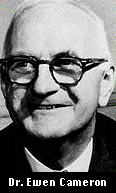
|
||
| Ewen Cameron
and The Allan Memorial Psychiatric Institute: A Study in Research
and Treatment Ethics "Psychic driving is a potent procedure - it invariably produces responses in the patient, and often intense responses" (Cameron, 1956, p. 508)
As an aside, on the surface it may not appear that this topic relates to the history of psychology in Canada. Dr. Cameron was a psychiatrist, and the Allan Memorial was a psychiatric institution. Cameron, himself, was not even a Canadian; he was born in Scotland and later immigrated to the United States. Despite working for 28 years in Canada, he never became Canadian and even maintained his residence south of the border in Lake Placid, New York (Collins, 1988). However, this topic bears on the discussion of the history of psychology in Canada because it looks at how modes of treatment have changed, how attitudes toward patients have changed, and, most importantly, because it was Canadians who were affected by what went on at the Allan Memorial. Psychic Driving, Ewen Cameron, and the Allan Memorial Psychiatric Institute
Cameron was an ambitious man. As Collins (1988) points out, he saw what was going on with the soldiers who were returning from the Second World War, and he wanted to be able to ease the stress and anxiety from which they were suffering. A loftier goal of Cameron’s was to conquer the process of aging. In time, he set up different research programs at the Allan Memorial. Of special interest to Cameron was the idea of sleep teaching. He had been in correspondence with Max Sherover, an American who had conquered his patients nail-biting habits by continuously playing a tape recording to them while they slept (Collins, 1988). Cameron began to experiment with the idea himself. He would, during a normal therapy session, record what he thought was a key statement that one of his patients had made (Gillmor, 1987). Later, Cameron would replay the statement repeatedly to the patient, in an attempt to break down the patient’s defense mechanisms and reach deeper material. Over time, Cameron developed this technique into a therapy that he called psychic driving. He introduced his form of therapy in a paper published in the American Journal of Psychiatry in January, 1956. As he explained it, psychic driving allowed for "the penetration of defenses, the elicitation of hitherto inaccessible material, and setting up of a dynamic implant" (Cameron, 1956, p. 503) or recurring thought that influenced the patient’s behaviour even after playback of the key statement had been stopped for some time. Cameron also reported that at times, the patient resisted listening to the repetition of the statement; this was handled by administering sodium amytal, a disinhibitant or "truth drug" (Collins, 1988), or by exposing the patient to the repetition during a period of prolonged sleep (Cameron, 1956). In his article, Cameron also admits to using stimulant drugs and LSD - without the patients’ consent - to disorganize the patient and thus allow the driving technique full access to the patient’s psyche. Collins (1988) explains that Cameron, keeping with the climate of the day, referred to his treatment as brainwashing; this term was en vogue in the 1950s, with the Cold War and Korean War fresh in everyone’s minds. The term "brainwashing" caught the eye of members of the American Central Intelligence Agency (CIA). During the Korean War, 70% of the 7,190 American prisoners of war "either made confessions or signed petitions calling for an end to the American presence in Asia" (Gillmor, |

 With
these words,
With
these words, 